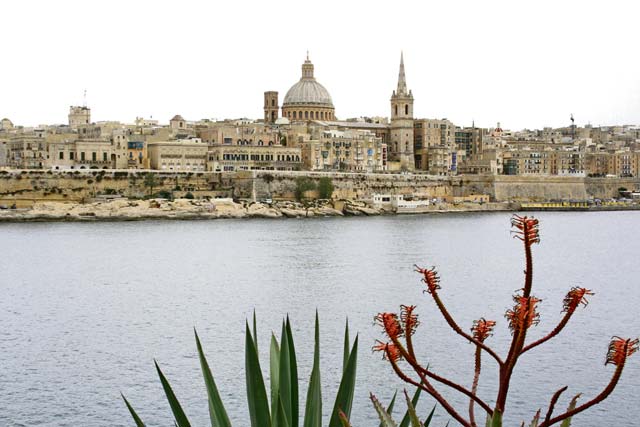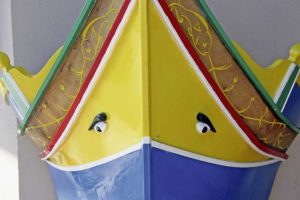
My husband and I weren’t quite sure what to expect when we escaped the dreary Kaiserslautern weather for a week in the sunshine of Malta. It seemed like a remote and romantic place, with its history of pirates and knights, invaders and heroes, shipwrecks, sieges and battles.
Malta is a country of three small rocky islands that sits just 60 miles south of Sicily in the Mediterranean. The landscape is rocky and beautiful with white limestone medieval hilltop cities rising above plains of villages and small garden plots subdivided by rock walls. Views of the Mediterranean are stunning. We were entranced by life in the old cities, built by the Knights of St. John to deter invasions of the islands. It is fun to get lost in the steep, narrow streets, finding hidden treasures of wine caves and restaurants, small shops selling specialty goods like glass and filigree jewelry, street vendors with local baked treats like passtizi or qassat, a delectable pastries filled with peas, ricotta cheese or whipped cream, and small plazas with cafes to enjoy a coffee or a fine local wine. Malta is a photographer’s dream with it’s old shop signs, painted wooden balconies, graceful doorways with ornamental gates, medieval architecture of grand palaces and churches, stray cats sunning themselves on crumbling stone walls.
We found Maltese natives to be friendly and helpful, and we fell into some interesting conversations with young and old people, which ranged from the education system in Malta to American politics. There was no language barrier, as the Maltese speak English in addition to Maltese. The food is superb. My husband tried the local specialty of rabbit stew served over spaghetti, and I enjoyed beautifully-prepared fresh fish. We also enjoyed the local wines, both red and white.
It is highly recommended to take tours in Malta, which will help you truly appreciate the rich history and culture and give you easier access to places like the Azure Window, blue caves and archaeological sites. Buses are the main form of transportation, and for €1.50, you can go just about anywhere on the main islands of Malta and Gozo. A ferry service connects these islands. Renting a car is not advised. Malta has the highest road accident rate in Europe; people drive on the left, the roads are narrow and speed limits and use of indicators seem to be optional. There are lots of hotels to choose from. We rented an apartment which gave us the experience of living like a local.

Malta has a fascinating history. It’s been a strategic country since trading began in the ancient world. Stonehenge-like temples on the main island were built 1,000 years before the pyramids of Egypt. Malta had a succession of conquering forces, including the Phoenicians; Romans; Arabs; Spanish; French; Knights of St. John, which survived a terrible siege by the Ottoman empire; Napoleon, who stayed all of six days; and the British, who helped the Maltese oust the French. History came to a head for Malta during World War II when the Nazi regime decided to bomb Malta out of existence. Malta was bombed night and day for 2 1/2 years but refused to surrender, earning the Maltese the Order of St. George at the end of the war.
Eisenhower, Patton and Montgomery met in secret war rooms built in bunkers below the city to plan the defense of Malta and the move of Allied troops into Italy. Tours of the Lascaris War Rooms, the War Museum, grand palaces and St. John’s Co-Cathedral give insights into the country’s history. Malta did not become an independent country until 1964.
The Maltese are resilient and deeply religious people. Graceful and ornate churches rise above each city in testament to their Catholic faith. Christianity came to Malta with St. Paul when he was shipwrecked here around A.D. 70.
The Maltese attribute their survival in WWII to their faith.
Malta is a 2 1/2-hour flight from Frankfurt. We highly recommend this small and beautiful country for an experience you will never forget.







